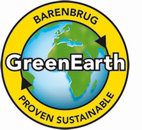Grass is first and foremost a sustainable plant. Because it can store so much carbon in the soil, it helps reduce the CO2 levels in the atmosphere. The blending of different types and varieties has led to a varied plant population that can stand up to all kinds of extremes. We can be thankful that so much can be done to ensure the sustainable use and maintenance of grass. One example of how we make the most of all the gifts that grass advancements bring us is that Barenbrug Research invests in current global topics of water savings and way to reduce the need for mowing.

Green Earth label
Barenbrug sets strict standards for our grass mixtures’ economic viability and sustainable use and management. As part of our belief in both, we grant what we call the Green Earth label to all grass seed mixtures which meet our standards. This quality label indicates that this grass, compared to preceding generations, has achieved a higher score for requirements limiting the use of water, pesticides and fertilisers, as well as the need for mowing. Grasses with this quality label are an immediate benefit for managers of public green spaces.
Water savings
Water savings and the need for clean drinking water is a crucial point of concern in the world today. Over the last ten years, we have been confronted with more extreme weather conditions than ever before, while spring and summer seasons seem to suffer more often from either long periods of drought or from heavy rains.
To be sure, the need for water for irrigation does not take precedence over all others – but it is necessary for the growth of crops, grass being one. Grass faces tougher challenges than in the past, due to climate change and increasing water shortages. Grass with long roots, however, can easily extract more water from the soil, thus reducing the need for irrigation.
Less need for mowing
One characteristic of sustainable grass management is less need for mowing. Because of high temperatures and more light, the sheer volume of grass can be overwhelming during growing season. This means that more frequent mowing is necessary, leading to higher costs for labour, fuel and machinery, not to mention a surge in CO2 emissions. Barenbrug has invested deeply into researching the biomass production of grass, and the investment has paid off. Our research shows not only that varieties differ from each other, but that growth height and grass production can also vary widely within a single variety. The Green Earth label is granted to varieties that need the lowest mowing frequency, thereby promoting fuel savings and reducing CO2 emissions.
All varieties and mixtures bearing the Green Earth label are independently tested by national and international research institutes. By setting strict requirements for the sustainability of grass, Barenbrug aims to work with managers of public green spaces to contribute to a healthy planet – for us and our children, and for today and for tomorrow.



